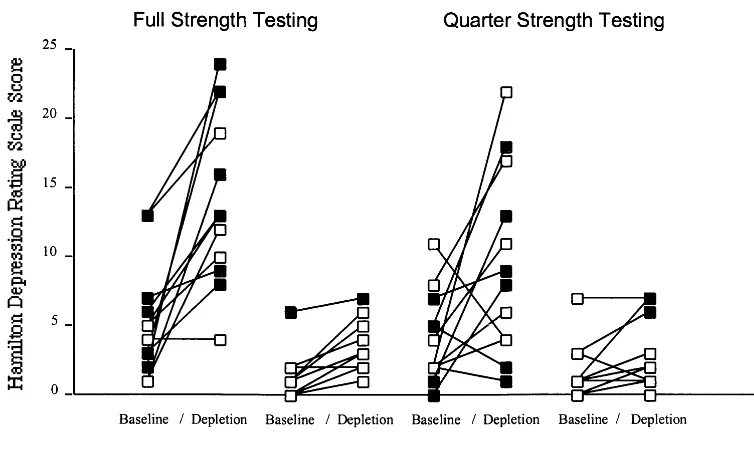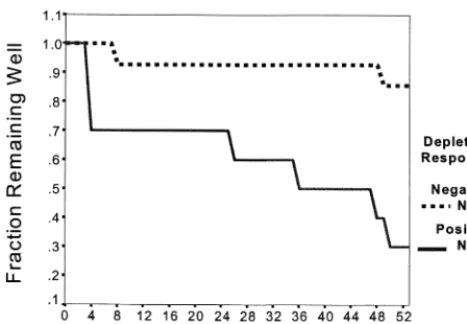Tryptophan Depletion and Risk of Depression Relapse:
A Prospective Study of Tryptophan Depletion as a
Potential Predictor of Depressive Episodes
Francisco A. Moreno, George R. Heninger, Cynthia A. McGahuey, and
Pedro L. Delgado
Background: This study investigated the relationship
between depressive symptom response during tryptophan depletion and future depressive episodes.
Methods: Twelve subjects with prior major depressive
episodes in remission and medication-free for$3 months (patients), and 12 matched healthy (control) subjects received two tryptophan depletion tests 1 week apart. During follow-up the Hamilton Depression Rating Scale was administered weekly for 1 month, monthly for 3 months, and once at 6 and 12 months.
Results: With results from both tests, tryptophan depletion
has a sensitivity of 78%, specificity of 80%, positive predictive value of 70%, and negative predictive value of 86% to identify future depressive episodes. Survival anal-ysis shows that mood response to tryptophan depletion reliably predicts major depressive episodes during the follow-up year (r 5.2725, p5 .014).
Conclusions: Tryptophan depletion may be clinically
useful in identifying individuals at risk for future major depressive episodes. Biol Psychiatry 2000;48:327–329 © 2000 Society of Biological Psychiatry
Key Words: Vulnerability, major depression, serotonin, depletion paradigm
Introduction
T
he development of procedures to identify individuals at biological risk for depression is highly desired. A variety of distinctive clinical features and laboratory find-ings have been proposed as potential predictors of major depressive episodes (MDEs; Horwath et al 1992; Keller et al 1983; Rush et al 1997). Although such tests havecontributed to a better understanding of the pathophysiol-ogy of depression, their clinical application is limited. Brain serotonin levels are dependent on plasma levels of tryptophan (TRP; Curzon 1981). Tryptophan depletion has been shown to induce mild depressive symptoms in 30% of subjects with a family history of mood disorder, but does not affect healthy subjects without personal or family history of mood disorder (Benkelfat et al 1994). Trypto-phan depletion also has been shown to induce depressive symptoms in medication-free subjects in remission from at least one prior MDE (Moreno et al 1999; Smith et al 1997). If subjects “at risk” for MDEs experience tempo-rary depressive symptoms during TRP depletion and healthy control subjects do not (Benkelfat et al 1994; Moreno et al 1999), TRP depletion may help to identify vulnerable individuals.
Methods and Materials
Subjects
Twelve subjects with a past history of at least one MDE but in clinical remission and medication free for at least 3 months and 12 age- and gender-matched control subjects with no personal or family history of any mental disorder participated in this study. After complete description of the study to the subjects, and discussion of the possibility of experiencing depressive symp-toms lasting from 6 to 24 hours during testing, written informed consent was obtained. The screening methods, and demographic and clinical characteristics of the subjects have been described in a previous report detailing the acute mood response to TRP depletion (Moreno et al 1999).
Procedure
DEPLETION. Subjects underwent two TRP depletion tests, separated by 1 week. One test used a 102-g, TRP-free, 15–amino acid drink to accomplish full TRP depletion (full-strength test). The other test involved a control preparation—a proportionally identical 25-g, TRP-free, 15–amino acid drink (quarter-strength test). This alternative control preparation was used due to a U.S. Food and Drug Administration ban on the use of TRP at the time
From the Department of Psychiatry, College of Medicine, The University of Arizona Health Sciences Center, Tucson (FAM, CAM, PLD) and the Depart-ment of Psychiatry, Yale University School of Medicine, New Haven, Connecticut (GRH).
Address reprint requests to Francisco A. Moreno, M.D., University of Arizona Health Sciences Center, Department of Psychiatry, 1501 N. Campbell Ave. 7-OPC, Tucson AZ 85724.
Received November 17, 1999; revised March 16, 2000; accepted March 24, 2000.
© 2000 Society of Biological Psychiatry 0006-3223/00/$20.00
the study was conducted. The experiment was conducted in a double-blind, crossover fashion, using a randomly assigned sequence of full- and quarter-strength tests. Behavioral ratings were obtained at baseline and at 5, 7, and 28 hours after the depletion drinks (Moreno et al 1999).
FOLLOW-UP. Subjects were monitored for depressive symptoms using the 25-item Hamilton Depression Scale (HAM-D; Mazure et al 1986) weekly for 1 month, and then monthly for 3 months. Retrospective HAM-D and Structured Clinical Interview for DSM-III-R (Spitzer 1987); depressive disorder section) interviews were performed at 6 and 12 months. Recurrence was defined as a return of symptoms of enough duration and severity to meet DSM-III-R criteria for an MDE, plus a doubling in HAM-D score with a total score$18.
Data Analysis
MOOD RESPONSE DURING TRP DEPLETION. As in prior studies, the highest HAM-D score observed during testing minus the baseline score was used for analysis. Post hoc iterations suggested that a change in HAM-D score of more than 5 points could be a reliable categoric marker for the prediction of a future depressive episode. Data were analyzed for each drink dose (quarter and full strength) and for both doses combined (selecting the highest “peak score”). To determine whether this categoric criterion would accu-rately separate individuals with a vulnerability for a future MDE from those without, a receiver operating characteristic analysis (Metz 1986) was performed comparing various change criteria to frequency of relapse. Fisher’s exact test was used to test the differences in frequency of new MDEs between categorical re-sponders to TRP depletion and nonrere-sponders. Survival analysis was performed using the Cox regression method.
Results
The acute biochemical and depressive effects of TRP deple-tion were transient, and subjects returned to baseline mood within 12 to 24 hours. No serious adverse events were observed, and no subject required treatment in response to TRP depletion. These data have been presented in a separate publication (Moreno et al 1999). A graphic presentation of HAM-D scores is included in Figure 1.
Nine of 24 subjects developed a new depressive episode in the year following TRP depletion. This included seven of 10 depletion responders (six patients and one control subject) and two of 14 depletion nonresponders (one patient and one control subject). Fisher’s exact test comparing both groups shows this difference to be statistically significant (p5.01). An increase in HAM-D of more than 5 points during depletion most accurately predicted depressive episodes in the follow-up year. Receiver operating characteristic analysis (Metz 1986) indicated that this cutoff was appropriate, with an area under the curve of .59 6 SD of .13 for the quarter-strength test, .706.11 for the full-strength test, and .77 6 .10 for the highest peak score from either test. Full-strength TRP depletion has a sensitivity of 60%, a specificity of 80%, a positive predictive value (PPV) of 66%, and a negative predictive value (NPV) of 75% for prediction of depressive episodes in the following year. On the other hand, quarter-strength TRP depletion has a sensitivity of 44%, specificity of 80%, PPV of 57%, and NPV of 71%. With selection of the highest response from either test, TRP depletion has a sensitivity of 78%, a specificity of 80%, a Figure 1. Mood effects of tryptophan depletion and prediction of depressive episodes. Baseline, ratings obtained immediately before ingestion of the amino acid drink; Depletion, highest score observed during testing after ingestion of the drink;h, did not experience depression during the follow-up year;■, experienced depression during the follow-up year.
328 BIOL PSYCHIATRY F.A. Moreno et al
PPV of 70%, and a NPV of 86%. Survival analysis using the Cox correlation method indicated that when the highest value of either test was used, there was a significant correlation (r5.2725, p5.014; Figure 2). When mood response from each depletion test was analyzed separately, the full-strength test had a statistically significant trend for predicting future episodes (r5 .141, p5 .08), whereas the quarter-strength test had a very limited ability to predict MDEs in the follow-up year (r50, p5.325).
The occurrence of MDEs in subjects during follow-up did not correlate significantly with age, gender, prior treatment form, length of remission, or number of MDEs.
Discussion
Depressive response to TRP depletion predicts new MEDs in the year after testing. Although depression is a highly heterogeneous condition, these findings suggest that indi-viduals having certain biological vulnerability for future depression may be exquisitely sensitive to even transient fluctuations in 5-HT availability. The implications of this for the pathophysiology of depression are discussed in a related publication (Moreno et al 1999).
Important limitations of this study include the preliminary nature of the findings; the small sample size; the lack of an ideal control condition requiring the use of a second, also “active,” test preparation (quarter-strength drink); the arbi-trary period of time chosen for follow-up; and the lack of face-to-face assessments in the latter portions of the follow-up. In spite of these limitations, these results are modest but consistent with prior published studies showing that individ-uals with a personal or family history of depression are more likely to experience mood symptoms during TRP depletion than those without such a history (Benkelfat et al 1994; Moreno et al 1999; Smith et al 1997).
Should these findings hold up on further study, TRP depletion testing may have promise for identifying people at
risk for future depression. Although the inherent risk of temporary induction of depressive symptomatology demands a very careful approach to these studies, the payoff of developing a tool that may potentially detect individuals who are vulnerable to developing depressive episodes may easily justify this approach. This may in turn allow for preventive strategies to be employed that diminish the suffering and disability associated with depression in a way similar to an exercise treadmill test or a glucose tolerance test that aids the diagnosis and treatment of coronary artery disease and diabetes, respectively.
Supported by National Institute of Mental Health Grant No. R01 MH48977 (PLD) and by National Research Service Award No. 5 T32 MH19126-07 (FAM).
The authors acknowledge Charlotte L. Powell, Penny Palmer, Donna DeWitt, B.S., Renee Collins, B.S., Marcy Watchman, Patricia Collins-Joyce, R.N., F.N.P., Judy Steward, M.S., R.N., Lynda Zentner, R.N., B.S., Cindi Laukes, M.F.A., Heather Stone Hopkins, M.A., and Mark Borgstrom, Ph.D., for their contribution to the manuscript.
Portions of these data have been presented in abstract form at the 151st annual meeting of the American Psychiatric Association, May 1998, Toronto, Canada (New Research Abstract No. 97) and at the 36th annual meeting of the American College of Neuropsychopharmacology, Decem-ber 1997, Waikoloa, Hawaii (Scientific Abstracts, 253).
References
Benkelfat C, Seletti E, Mark A, Dean P, Palmour RM, Young SN (1994): Mood-lowering effects of tryptophan depletion: En-hanced susceptibility in young man at genetic risk for major affective disorders. Arch Gen Psychiatry 51:687– 697. Curzon G (1981): Influence of plasma tryptophan on brain 5-HT
synthesis and serotonergic activity. In: Haber B, Gabay S, editors. Serotonin: Current Aspects of Neurochemistry and
Function. New York: Plenum Press, 207–219.
Horwath E, Johnson J, Klerman GL, Weissman MM (1992): Depressive symptoms as relative and attributable risk factors for first-onset major depression. Arch Gen Psychiatry 49:817– 823. Keller MB, Lavori PW, Lewis CE, Klerman GL (1983): Predictors of relapse in major depressive disorder. JAMA 250:3299 –3304. Mazure CM, Nelson JC, Price LH (1986): Reliability and validity of the symptoms of major depressive illness. Arch
Gen Psychiatry 43:451– 456.
Metz CE (1986): ROC methodology in radiologic imaging.
Invest Radiol 21:720 –733.
Moreno FA, Gelenberg AJ, Heninger GR, Potter RL, McKnight K, Allen J, et al (1999): Tryptophan depletion and depressive vulnerability. Biol Psychiatry 46:498 –505.
Rush AJ, Giles DE, Schlesser MA, Orsulak PJ, Weissenburger JE, Fulton CL, et al (1997): Dexamethasone response, thyrotropin-releasing hormone stimulation, rapid eye movement latency, and subtypes of depression. Biol Psychiatry 41:915–928.
Smith KA, Fairburn CG, Cowen PJ (1997): Relapse of depres-sion after rapid tryptophan depletion. Lancet 349:915–919. Spitzer RL (1987): Structured Clinical Interview for DSM III-R.
New York: New York State Psychiatric Institute, Biometrics Research Department.
Figure 2. Relapse prediction: 1-year follow-up.

